
A Guide to the B2B BANT Framework
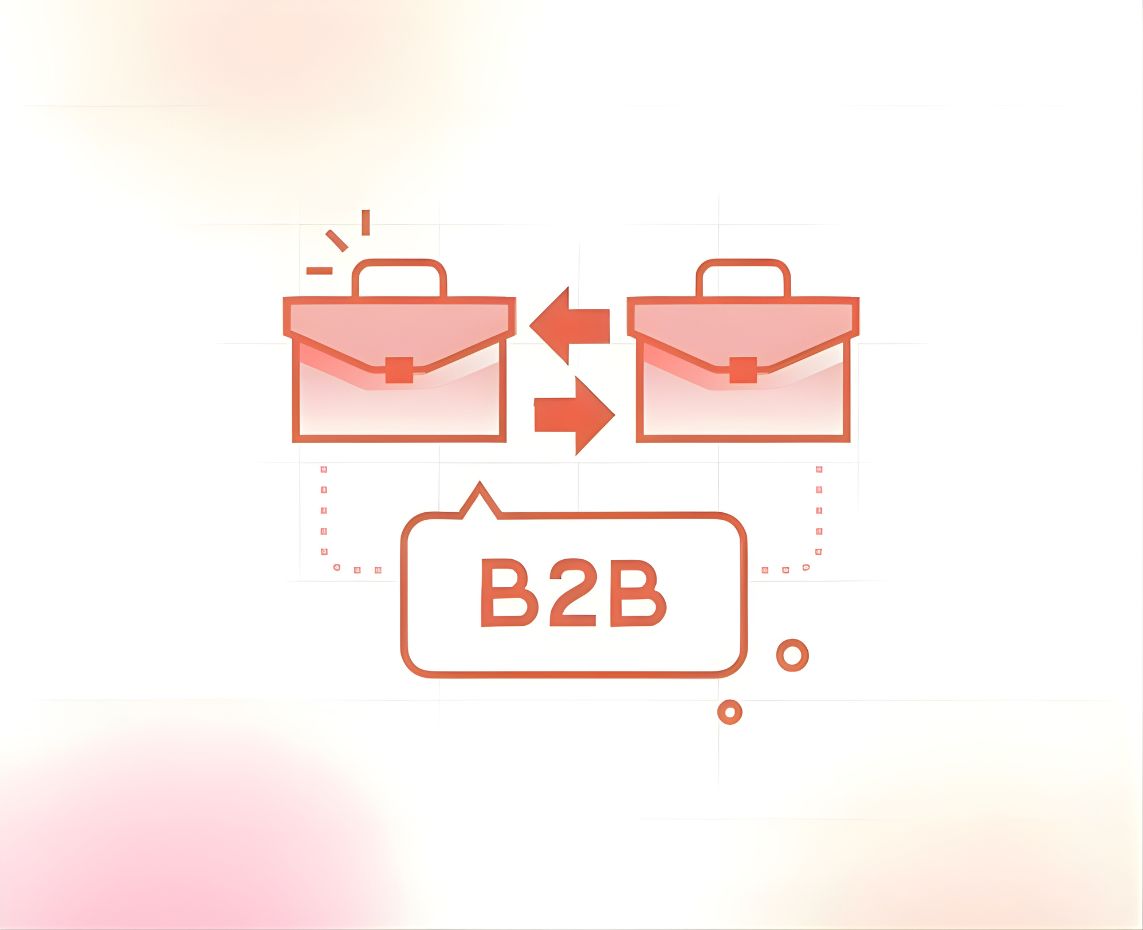
Generating new leads is one thing, but qualifying them effectively is another. Many sales teams spend valuable hours chasing prospects that never convert, resulting in inefficiencies that directly impact revenue. In fact, 42% of B2B companies report challenges with low-quality or irrelevant leads, indicating a struggle to distinguish between promising prospects and time-wasters.
One of the longest-standing methods to assess lead potential is the B2B BANT framework. For decades, it has served as a reliable method for sales teams to assess which prospects deserve priority attention. While some view it as a traditional model, its principles continue to influence how companies structure their qualification process.
In this guide, we’ll explore the B2B BANT framework and its continued effectiveness in enhancing lead quality and strengthening the pipeline.
Quick Overview
- BANT (Budget, Authority, Need, Timeline) is a structured framework for qualifying B2B leads.
- Leads are evaluated based on financial capacity, decision-making authority, specific business needs, and urgency.
- Targeted questions for each BANT element help gather actionable insights during initial prospect interactions.
- Defining an ICP, integrating BANT into CRM, and reviewing the process regularly ensure effective implementation.
- Using BANT improves lead prioritization, enhances conversion rates, and supports a healthier, more predictable sales pipeline.
What is the BANT Framework?
The B2B BANT framework is a sales qualification method originally developed by IBM in the 1960s to help its sales teams systematically evaluate prospects. The acronym stands for Budget, Authority, Need, and Timeline, four factors that together determine whether a prospect is ready and able to move forward in the buying process.
Over time, this framework has become a standard reference point in B2B sales, providing a structured approach to evaluating lead quality.
Now, let’s take a look at the criteria used to qualify leads effectively.
Also Check: Definitive Guide to B2B Lead Generation Strategies.
BANT Lead Qualification Criteria
The strength of the BANT framework lies in its four qualification factors. Each one helps sales teams evaluate whether a prospect is worth investing time and effort in.
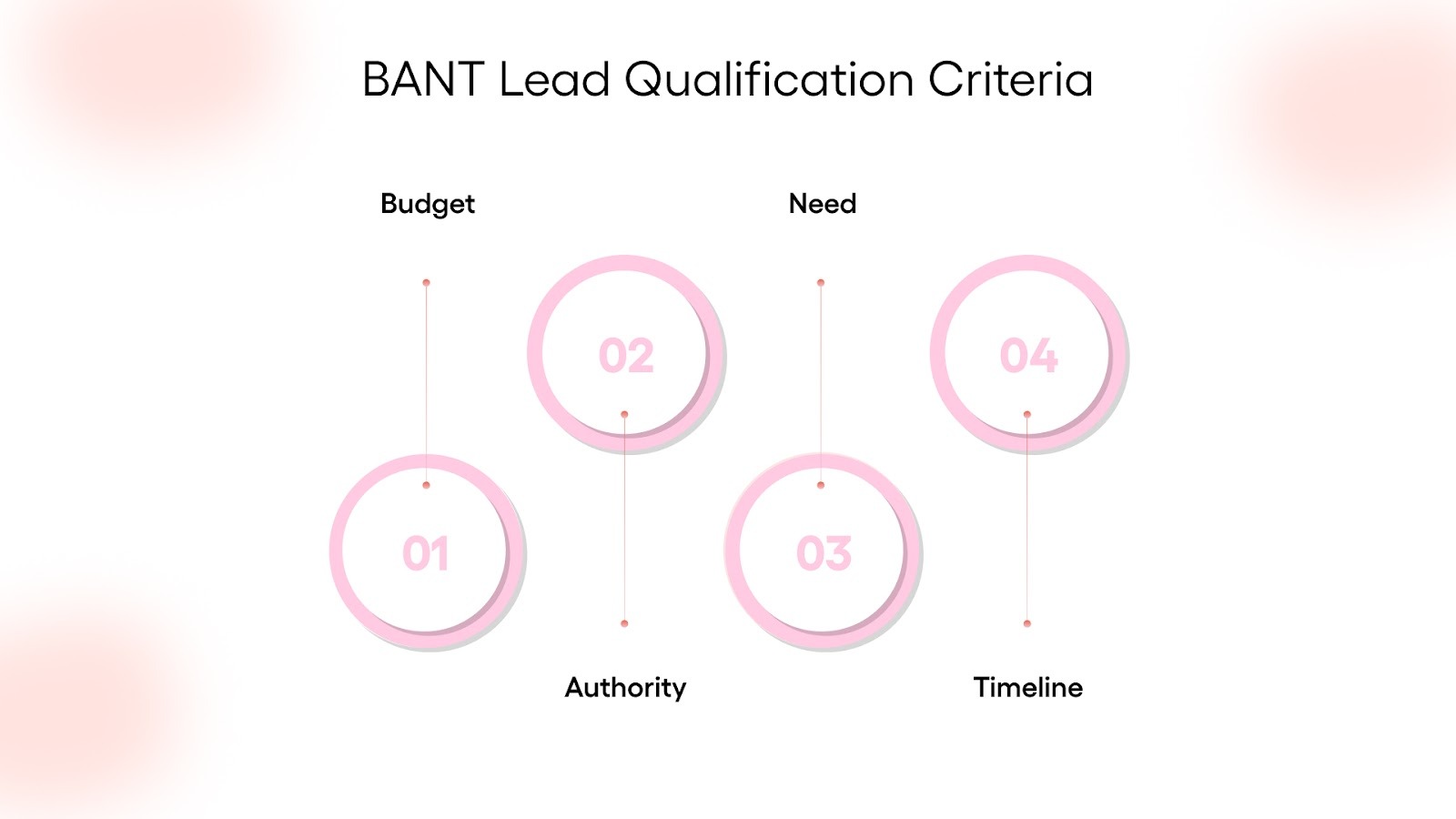
1. Budget
Assessing the budget goes beyond knowing if a prospect has money. Ask about their project funding, approval limits, and allocation priorities. Understand if the investment aligns with their business goals. This helps prioritize leads that can realistically support monthly recurring revenue (MRR).
2. Authority
Identify who makes the final purchasing decision and who influences it. In B2B deals, multiple stakeholders may be involved. Mapping decision-makers ensures your outreach targets the right individuals, reducing stalled deals and missed opportunities.
3. Need
Analyze the prospect’s business challenges and objectives. What problems are they trying to solve? How urgent are these issues? Understanding need ensures your solution aligns with measurable outcomes, such as cost reduction, improved efficiency, or operational scalability.
4. Timeline
Clarify the prospect’s decision-making schedule. Are they looking for an immediate solution, or is the project planned for the next quarter? Knowing the timeline allows sales teams to sequence follow-ups effectively and prioritize opportunities that can close within predictable periods.
Once you understand the BANT criteria, the next step is asking the right questions at the right time.
Recommended: How to Effectively Get More Qualified Leads.
Qualification Questions For B2B BANT Framework
Well-prepared questions make it easier to gather accurate information without overwhelming the prospect. Here are some examples:
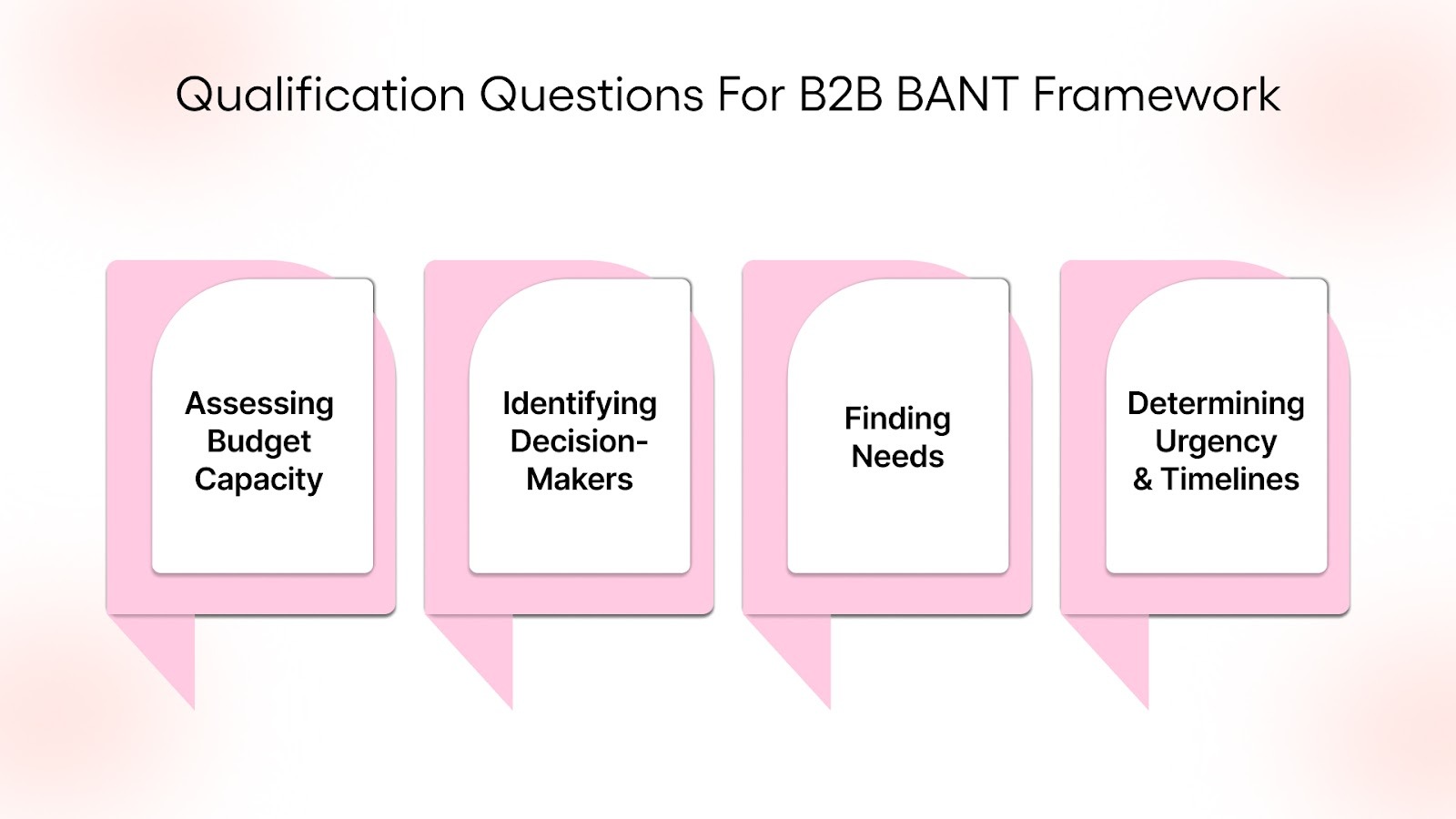
1. Assessing Budget Capacity
Budget questions reveal whether the prospect has the financial capacity and prioritization to invest in your solution. They help avoid spending time on leads that cannot move forward.
- What is your budget for this project or solution?
- How are funds currently allocated for this area?
- Is there a specific budget approval process we should be aware of?
- Are there any constraints that could impact your ability to move forward?
2. Identifying Decision-Makers and Authority
Authority questions identify who can make the final decision and who influences it. Knowing this ensures your sales efforts are directed toward the right individuals.
- Who will be involved in the decision-making process?
- Who signs off on final approval for purchases like this?
- Are there other stakeholders we should include in discussions?
- How are decisions typically made for initiatives like this?
3. Finding Needs and Business Outcomes
Need-focused questions uncover the prospect’s challenges and goals. They show whether your solution addresses a real business problem.
- What challenges are you currently facing in this area?
- How is this problem affecting your team or business?
- What outcomes are you hoping to achieve with a solution?
- Have you tried any solutions so far? If yes, what worked and what didn’t?
4. Determining Urgency and Timelines
Timeline questions determine urgency and expected decision-making periods. They help sales teams prioritize follow-ups and align resources efficiently.
- When do you plan to implement a solution?
- Are there any deadlines or milestones driving this decision?
- How quickly do you need to see results from this project?
- What is the typical timeline for decisions of this type in your organization?
Now, let’s take a look at how you can integrate BANT into your B2B sales workflow for practical results.
Also Read: Ultimate Lead Qualification Checklist: Convert More Sales in 2025.
Implementing BANT in B2B Sales
Applying the B2B BANT framework effectively requires a structured approach. Sales teams can integrate it into their processes to ensure lead qualification is consistent and data-driven.
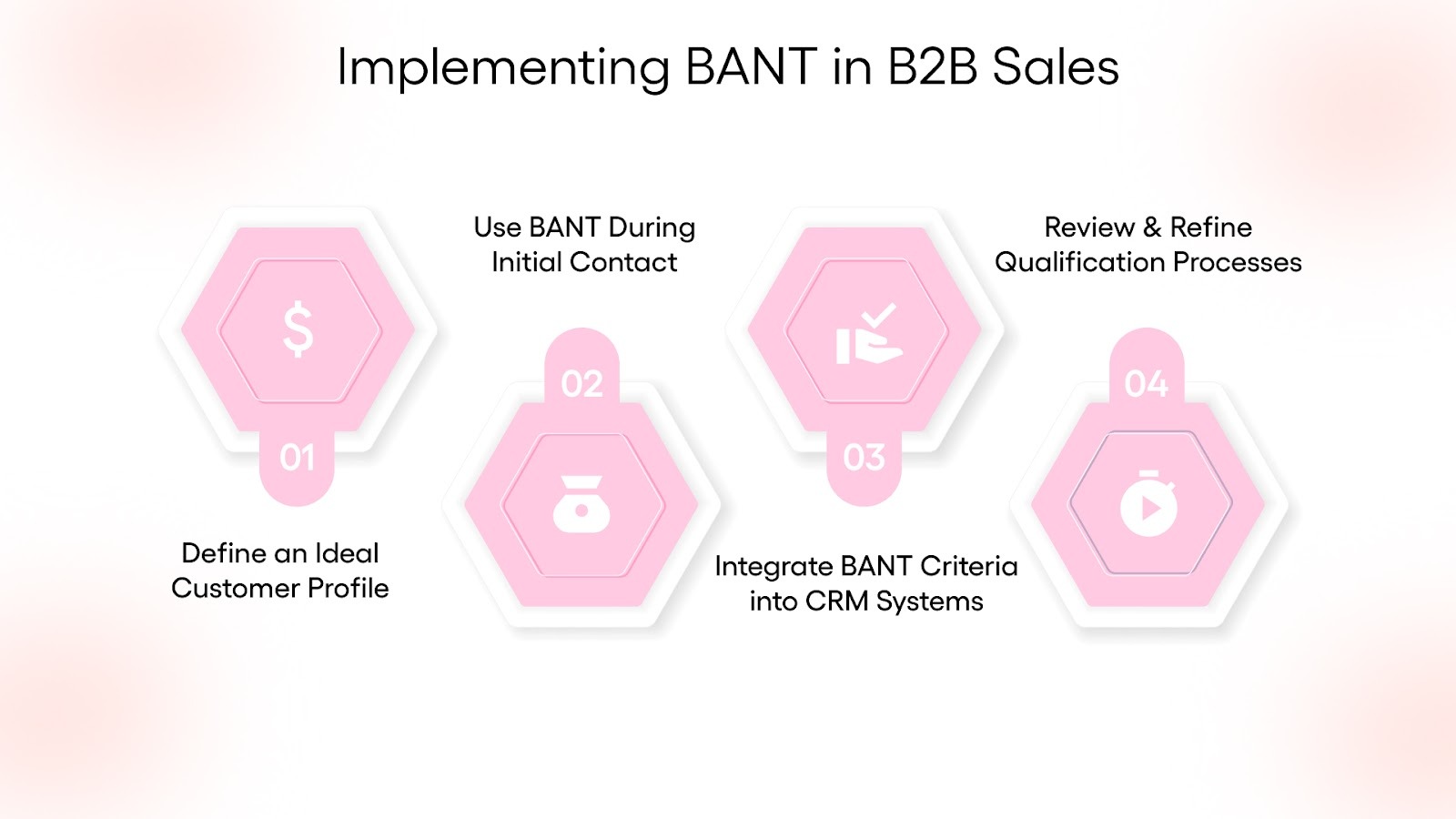
1. Define an Ideal Customer Profile (ICP)
Start by clearly identifying your ICP. Knowing the industries, company sizes, and roles most likely to benefit from your solution helps target prospects that fit your BANT criteria. A well-defined ICP ensures you spend time on leads with higher potential to convert and generate recurring revenue.
2. Use BANT During Initial Contact
Incorporate BANT questions early in discovery calls or emails. Gathering information about budget, authority, need, and timeline from the start saves time and reduces follow-ups with unqualified leads. Early qualification also helps sales teams focus on opportunities that align with business goals.
3. Integrate BANT Criteria into CRM Systems
Documenting BANT information in your CRM allows teams to track lead quality and progress. Custom fields for budget, decision-makers, pain points, and timelines create visibility for the entire sales organization. This also supports reporting and enables better forecasting of opportunities.
4. Review and Refine Qualification Processes
Regularly analyze your BANT assessments to identify trends and gaps. Sales teams can refine questions, adjust scoring methods, and update ICP definitions based on feedback. Continuous improvement ensures the framework remains aligned with changing business needs and maximizes lead conversion potential.
However, to get the most from BANT, it’s important to adopt best practices, incorporate modern enhancements, and track key metrics for ongoing success.
Also, check our blog for proven Strategies and Techniques for a Strong Lead Generation Pipeline.
Best Practices for BANT Framework
Sales teams can follow the best practices given below, implement modern strategies, and monitor performance to maximize results.
- Focus on Early Qualification: Ask BANT questions during initial contact to quickly assess lead potential. Avoid waiting too long, as this can waste time on unqualified prospects.
- Engage Multiple Stakeholders: Map decision-makers and influencers to ensure outreach reaches the right people. Mistake: assuming a single contact can approve the purchase.
- Adapt Questions to Context: Tailor your questions to the prospect’s business situation. Avoid rigid scripts that feel generic or irrelevant.
- Revisit BANT Periodically: Prospects' needs and budgets can change. Failing to update assessments may lead to missed opportunities.
Modern Strategies
Integrating BANT with new tools and strategies increases precision and efficiency.
- Intent Data: Use prospect activity signals to prioritize leads showing high engagement or interest.
- Lead Scoring: Assign scores based on BANT criteria to rank opportunities objectively and focus on the highest potential leads.
- ABM Sync: Align BANT qualification with account-based marketing campaigns for coordinated outreach to high-value targets.
Metrics & KPIs to Monitor Success
Tracking performance ensures BANT drives measurable results. Key metrics include:
- Qualified Lead Conversion Rate: Percentage of BANT-qualified leads that move to opportunities.
- Sales Cycle Duration: Average time from initial contact to deal closure.
- Lead Disqualification Reasons: Helps refine BANT questions and ICP targeting.
- Pipeline Coverage vs. Revenue Goals: Measures whether qualified leads align with MRR targets.
Next, let’s understand its tangible benefits and see why it’s a valuable tool for sales teams.
Read: Smart Sales Tactics for 2025: How to Drive Revenue the Right Way.
Benefits of Using BANT
The BANT framework provides a structured approach to lead qualification, helping sales teams focus on opportunities with the highest potential. Key benefits include:
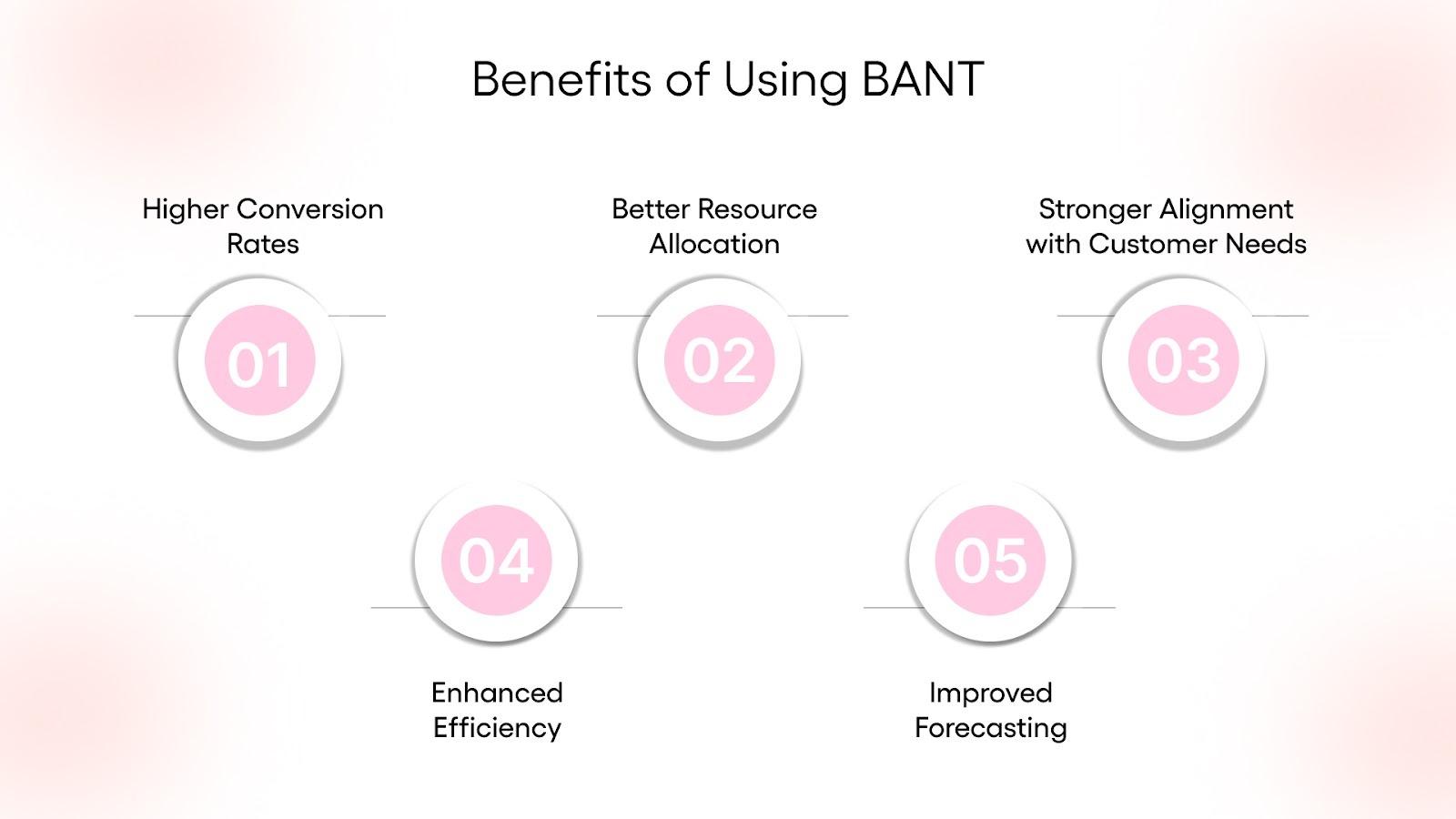
- Higher Conversion Rates: By prioritizing prospects with budget, authority, need, and a clear timeline, teams engage with leads more likely to move through the sales process successfully.
- Better Resource Allocation: Sales and marketing resources can be directed toward high-potential opportunities. This ensures time, effort, and budget are invested where they will have the greatest impact on monthly recurring revenue (MRR).
- Stronger Alignment with Customer Needs: BANT encourages a focus on the prospect’s challenges and objectives. Teams can tailor solutions to match business needs, increasing the likelihood of a meaningful engagement.
- Enhanced Efficiency: Focusing on leads that meet BANT criteria reduces time spent on unqualified prospects. Sales teams can concentrate their efforts where they are most likely to generate results.
- Improved Forecasting: Tracking BANT information provides clearer visibility into pipeline health. Accurate data on lead quality and timelines allows for better sales forecasting.
While BANT offers clear advantages, it also comes with challenges and limitations that sales teams need to be aware of.
Challenges and Limitations of BANT
While BANT is a widely used qualification framework, it has limitations that sales teams should be aware of.
- Rigidity and Overemphasis on Budget: Focusing too heavily on budget can exclude leads with strong potential. Some prospects may find funding later or prioritize high-value solutions differently.
- Difficulty in Complex Buying Groups: In organizations with multiple stakeholders, identifying all decision-makers and influencers can be challenging. BANT alone may not capture the full decision-making process.
- Overlooking Relationship Building and Emotional Drivers: BANT emphasizes logical criteria but may miss personal or emotional factors that influence decisions. Building trust and rapport is still essential.
- Situations Where BANT Alone is Insufficient: For long sales cycles or highly strategic deals, BANT may need to be combined with other frameworks or insights to evaluate lead potential accurately.
Given these limitations, it’s useful to see how BANT compares with other lead qualification methods and when alternative frameworks might be more suitable.
Comparing BANT with Other Lead Qualification Methods
BANT is one of several frameworks used in B2B sales to evaluate leads. While it is straightforward and widely recognized, other methods offer alternative approaches that may suit different sales contexts.
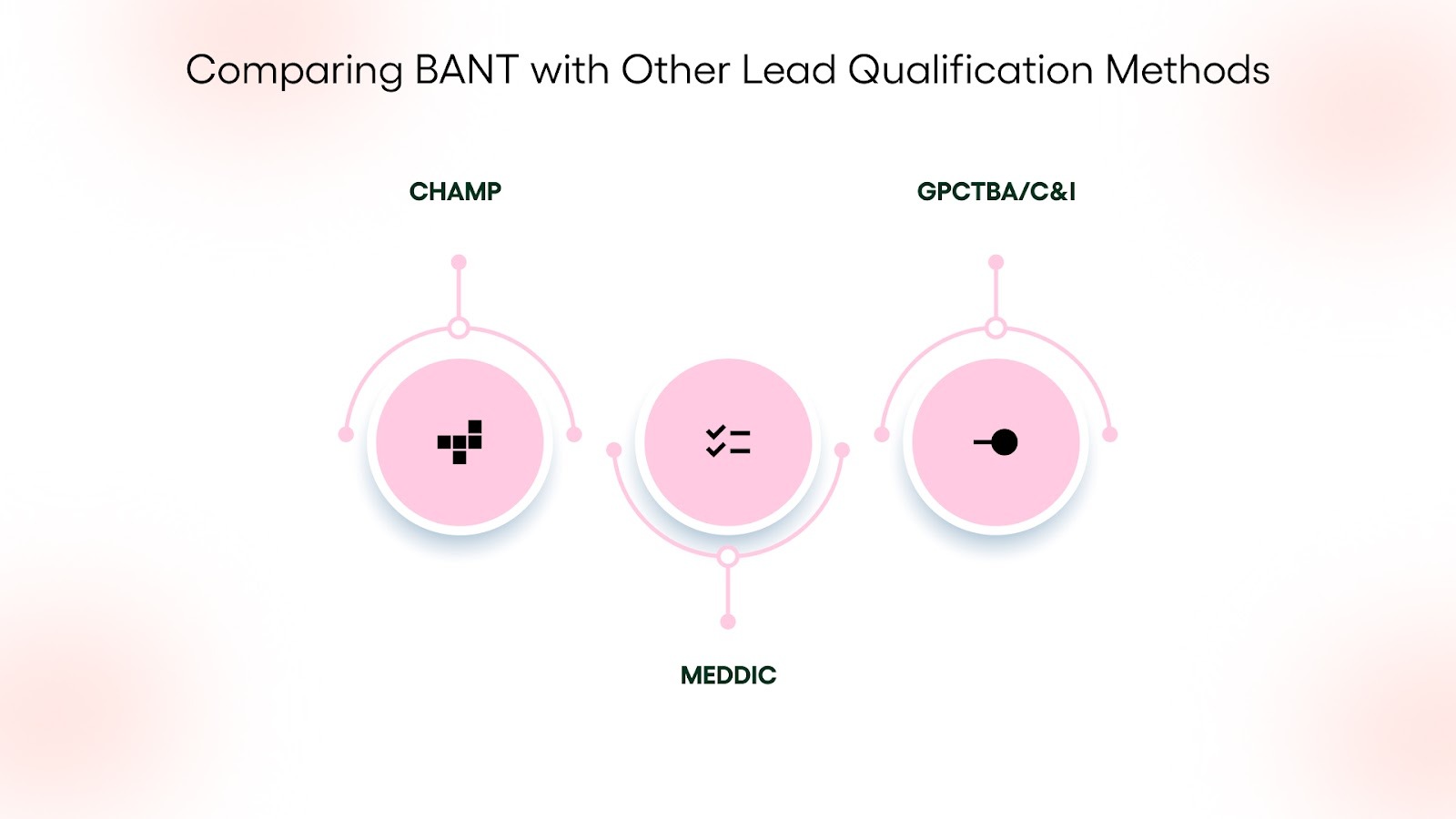
1. CHAMP
CHAMP focuses on Challenges, Authority, Money, and Prioritization. Unlike BANT, it emphasizes understanding the prospect’s pain points and applying empathy to tailor solutions. This approach is particularly useful when uncovering challenges is more important than immediate budget or timeline.
2. MEDDIC
MEDDIC provides a detailed assessment of the decision-making process. It considers Metrics, Economic buyer, Decision criteria, Decision process, Identify pain, and Champion. This framework is ideal for complex B2B deals involving multiple stakeholders and longer sales cycles.
3. GPCTBA/C&I
GPCTBA/C&I takes a comprehensive view, evaluating Goals, Plans, Challenges, Timeline, Budget, Authority, Consequences, and Implications. It is designed to connect a prospect’s strategic goals with your solution, making it effective for enterprise sales and long-term account development.
Each lead qualification framework has its strengths and weaknesses. Teams can select one based on deal complexity, prospect type, and organizational structure. At TLM (The Lead Market), we implement a proven framework tailored to your business, optimizing B2B lead generation. For instance, a Melbourne-based GRC firm improved lead quality and boosted sales by partnering with TLM.
Make B2B Lead Qualification More Effective with TLM
Effective lead qualification is essential to focus on prospects with the highest potential and avoid wasting time on unqualified leads. Many sales teams struggle with low-quality leads, unclear decision-making hierarchies, and missed timelines, issues that can stall pipeline growth and impact MRR.
TLM (The Lead Market) helps businesses address these challenges by applying structured frameworks like BANT alongside advanced B2B sales strategies. Our services ensure your sales team engages only with qualified prospects, saving time and increasing conversion potential. Key offerings include:
- Sales Qualified Leads (SQL): High-quality leads ready for sales engagement.
- Appointment Scheduling: Converting leads into confirmed meetings efficiently.
- Demand Generation: Nurturing prospects until they are ready to buy.
- Targeted Campaigning & ABM: Personalized outreach to high-value accounts.
FAQs
What does BANT methodology mean in sales?
BANT is a lead qualification framework that stands for Budget, Authority, Need, and Timeline. It helps sales teams assess whether a prospect is a good fit by evaluating their financial capacity, decision-making power, specific needs, and urgency to purchase.
How do I assess a prospect's budget using BANT?
Assessing a prospect’s budget involves more than asking for a dollar amount. Start by understanding if funds are already allocated for this project or solution. Ask about the financial decision-making process, such as who approves budgets and whether there are spending limits or competing priorities.
What are some effective questions to identify a prospect's authority?
Ask questions like:
- "Who is responsible for making purchasing decisions?"
- "Are there other stakeholders involved in the approval process?"
- "What is the decision-making hierarchy within your organization?"
These questions help determine if you're engaging with the right person who has the authority to make purchasing decisions.
How can I determine a prospect's need for my solution?
To uncover a prospect's needs, ask about their current challenges, goals, and any problems they're seeking to solve. Questions like "What issues are you currently facing?" or "What objectives are you aiming to achieve?" can provide insights into whether your product or service aligns with their requirements.
What questions help assess a prospect's timeline?
Inquire about their desired implementation date, any upcoming events influencing the decision, and the urgency of their needs. Questions such as "When are you looking to implement a solution?" or "What is your timeline for making a decision?" can clarify their purchasing schedule.





